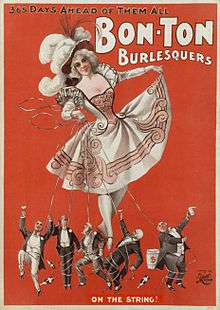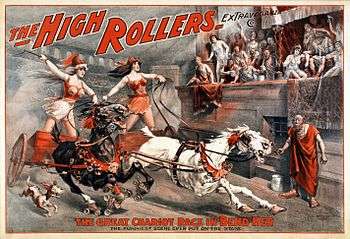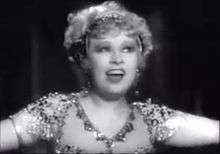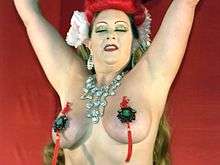American burlesque

American burlesque is a genre of variety show. Derived from elements of Victorian burlesque, music hall and minstrel shows, burlesque shows in America became popular in the 1860s and evolved to feature ribald comedy (lewd jokes) and female striptease. By the early 20th century, burlesque in America was presented as a populist blend of satire, performance art, music hall, and adult entertainment, featuring striptease and broad comedy acts.[1]
The entertainment was presented often in cabarets and clubs, as well as music halls and theatres. Performers, usually female, often created elaborate tableaux with lush, colorful costumes, mood-appropriate music, and dramatic lighting; novelty acts, such as fire breathing or contortionists, might be added to enhance the impact of their performance.[2] The genre traditionally encompassed a variety of acts: in addition to the striptease artistes, there was some combination of chanson singers, comedians, mime artists, and dancing girls, all delivered in a satiric style with a saucy edge. The striptease element of burlesque became subject to extensive local legislation, leading to a theatrical form that titillated without falling foul of censors.[1]
Burlesque gradually lost popularity beginning in the 1940s. A number of producers sought to capitalize on nostalgia for the entertainment by attempting to recreate the spirit of burlesque in Hollywood films from the 1930s to the 1960s. There has been a resurgence of interest in this format since the 1990s, and it inspired a 2010 musical film, Burlesque, starring Christina Aguilera and Cher.
Literary and theatrical origins
The term "burlesque" more generally means a literary, dramatic or musical work intended to cause laughter by caricaturing the manner or spirit of serious works, or by ludicrous treatment of their subjects.[3] Burlesque in literature and in theatre through the 19th century was intentionally ridiculous in that it imitated several styles and combined imitations of certain authors and artists with absurd descriptions.[4] Burlesque depended on the reader's (or listener's) knowledge of the subject to make its intended effect, and a high degree of literacy was taken for granted.[5]
Victorian burlesque, sometimes known as "travesty" or "extravaganza",[6] was popular in London theatres between the 1830s and the 1890s. It took the form of musical theatre parody in which a well-known opera, play or ballet was adapted into a broad comic play, usually a musical play, often risqué in style, mocking the theatrical and musical conventions and styles of the original work, and quoting or pastiching text or music from the original work. The comedy often stemmed from the incongruity and absurdity of the classical subjects, with realistic historical dress and settings, being juxtaposed with the modern activities portrayed by the actors.[7] The dialogue was generally written in rhyming couplets, liberally peppered with bad puns.[8] A typical example from a burlesque of Macbeth: Macbeth and Banquo enter under an umbrella, and the witches greet them with "Hail! hail! hail!" Macbeth asks Banquo, "What mean these salutations, noble thane?" and is told, "These showers of 'Hail' anticipate your 'reign'".[9] A staple of theatrical burlesque was the display of attractive women in travesty roles, dressed in tights to show off their legs, but the plays themselves were seldom more than modestly risqué.[10]
Burlesque in America

There were three main influences on American burlesque in its early years: Victorian burlesque, "leg shows" and minstrel shows.[11] British-style burlesques had been successfully presented in New York as early as the 1840s.[12] They achieved wide popularity with productions by Lydia Thompson and her troupe, the British Blondes, who first appeared in the United States in 1868.[13] "Leg" shows, such as the musical extravaganza The Black Crook (1866), became popular around the same time.[14] The influence of the minstrel show soon followed; one of the first American burlesque troupes was the Rentz-Santley Novelty and Burlesque Company, created in 1870 by Michael B. Leavitt, who had earlier feminized the minstrel show with his group Madame Rentz's Female Minstrels.[15] American burlesque rapidly adopted the minstrel show's tripartite structure: part one was composed of songs and dances rendered by a female company, interspersed with low comedy from male comedians. Part two featured various short specialties and olios in which the women did not appear. The show's finish was a grand finale. Sometimes the entertainment was followed by a boxing or wrestling match.[11]
Originally, burlesque performances included comic sketches lampooning the upper classes and high art, such as opera, Shakespearean drama, and classical ballet.[16] The genre developed alongside vaudeville and ran on competing circuits.[17] Possibly due to historical social tensions between the upper classes and lower classes of society,[18] much of the humor and entertainment of later American burlesque focused on lowbrow and ribald subjects.[17]
By the 1880s, the four distinguishing characteristics of American burlesque had evolved:
- Minimal costuming, often focusing on the female form.
- Sexually suggestive dialogue, dance, plotlines and staging.
- Quick-witted humor laced with puns, but lacking complexity.
- Short routines or sketches with minimal plot cohesion across a show.[1]
The artist and writer Jerome Myers gave a view of burlesque as observed in the working-class neighborhoods of New York in the early years of the 1900s:
I have been impressed by the sincerity of the audience. On the runway extending out over the orchestra, the girls would gesture back and forth. It was not always of beauty; yet never that I can remember did these onlooking men, by word or gesture, annoy or belittle the performers. Pitifully inadequate the girls often were for their parts; yet they were working girls, catering to an audience of men who also worked for a living.[A]mong these imitation actresses, I have seen at times real jewels, featured girls who exercised all their youth and talent, working an enchantment within their narrow limits. There was one young girl who did the so-called strip-tease act. Playfully casting away her garments, she disclosed the full glory of her beautiful figure, her movements unsurpassed in a harmony of action. Had that inspired girl had the benefit of a French or German background of publicity, she would have revealed her art to a top-hat audience. Susceptible artists would have filled their sketch-books, photographers would have vied with one another, books of laudation would have appeared, and a world celebrity would have danced onto the newspaper pages. Yet this audience of ordinary people, in this ordinary burlesque theatre, applauded her in their simple way, and for years kept on applauding her as a featured artist, her name up in electric lights."[19]

Charlie Chaplin (who starred in the 1915 film Burlesque on Carmen) noted in 1910: "Chicago ... had a fierce pioneer gaiety that enlivened the senses, yet underlying it throbbed masculine loneliness. Counteracting this somatic ailment was a national distraction known as the burlesque show, consisting of a coterie of rough-and-tumble comedians supported by twenty or more chorus girls. Some were pretty, others shopworn. Some of the comedians were funny, most of the shows were smutty harem comedies – coarse and cynical affairs".[20]
By the early 20th century, there were two national circuits of burlesque shows, as well as resident companies in New York, such as Minsky's at the Winter Garden.[11] The uninhibited atmosphere of burlesque establishments owed much to the free flow of alcoholic liquor, and the enforcement of Prohibition was a serious blow.[21] The popular burlesque show of this period eventually evolved into the striptease which became the dominant ingredient of burlesque by the 1930s. At first soubrettes showed off their figures while singing and dancing; some were less active but compensated by appearing in elaborate stage costumes.[1] Exotic "cooch" dances (similar to bellydancing) were brought in, ostensibly Syrian in origin.[11] Strippers gradually supplanted the singing and dancing soubrettes; by 1932 there were at least 150 strip principals in the US.[1] The transition from traditional burlesque to striptease is depicted in the film The Night They Raided Minsky's (1968).[2]
By the late 1930s, a social crackdown on burlesque shows began their gradual downfall. The shows had slowly changed from ensemble ribald variety performances, to simple performances focusing mostly on the striptease.[1] In New York, Mayor Fiorello LaGuardia clamped down on burlesque, effectively putting it out of business by the early 1940s.[22] Burlesque lingered on elsewhere in the U.S., increasingly neglected, and by the 1970s, with nudity commonplace in theatres, American burlesque reached "its final shabby demise".[23]
Burlesque shows on film

During its declining years and afterwards, films sought to capture the spirit of American burlesque. For example, in I'm No Angel (1933), Mae West performed a burlesque act. The 1943 film Lady of Burlesque, although a murder-mystery, spends much of its running time depicting the back-stage life of burlesque performers.[24]
The first motion-picture adaptation of an actual burlesque show was Hollywood Revels (1946). Much of the action was filmed in medium or long shots, because the production was staged in a theater and the camera photographed the stage from a distance. In 1947, film producer W. Merle Connell reinvented the filmed burlesque show by restaging the action especially for films, in a studio, where he could control the camerawork, lighting and sound, providing close-ups and other studio photographic and editorial techniques. His 1951 production French Follies recreates a classic American burlesque presentation, with stage curtains, singing emcee, dances by showgirls and strippers, comic sketches and a finale featuring the star performer. The highlight is the famous burlesque routine "Crazy House", popularized earlier by Abbott and Costello. Another familiar sketch, "Slowly I Turned" (later famous as a Three Stooges routine), was filmed for Connell's 1953 feature A Night in Hollywood.

Other producers entered the field, using color photography and even location work. Naughty New Orleans (1954) is an example of burlesque entertainment on film, equally showcasing girls and gags, although it shifts the venue from a burlesque-house stage to a popular nightclub. Photographer Irving Klaw filmed a very profitable series of burlesque features, usually featuring star pin-up girl Bettie Page and various lowbrow comedians (including future TV star Joe E. Ross). Page's most famous features are Striporama (1953),[25] Varietease (1954) and Teaserama (1955). These films, as their titles imply, were only teasing the viewer: the girls wore revealing costumes, but there was never any nudity. In the late 1950s, however, provocative films emerged, sometimes using a "nudist colony" format, and the relatively tame burlesque-show film died out.
As early as 1954, burlesque was already considered a bygone form of entertainment; burlesque veteran Phil Silvers laments the passing of burlesque in the musical Top Banana. The Night They Raided Minsky's (1968) celebrates classic American burlesque.[2]
Neo-Burlesque

A new generation nostalgic for the spectacle and perceived glamour of the old times determined to bring burlesque back. This revival was pioneered independently in the early 1990s by Billie Madley's "Cinema" and later with Ami Goodheart in "Dutch Weismann's Follies" revues in New York, Michelle Carr's "The Velvet Hammer" troupe in Los Angeles, and The Shim-Shamettes in New Orleans. Ivan Kane's Royal Jelly Burlesque Nightclub at Revel Atlantic City opened in 2012.[27] Inspired by old time stars like Sally Rand, Tempest Storm, Gypsy Rose Lee, and Lili St. Cyr, more recent performers include Dita Von Teese, Julie Atlas Muz, and Anne McDonald.[28][29] Agitprop groups such as Cabaret Red Light have included political satire and performance art in their acts.
Today, Neo-Burlesque has taken many forms, but all have the common trait of honoring one or more of burlesque's previous incarnations, with acts including striptease, expensive costumes, bawdy humor, cabaret, and comedy/variety acts.[30][31] There are modern burlesque performers and shows all over the world, and annual conventions such as the Vancouver International Burlesque Festival, the New York Burlesque Festival created by burlesque star Angie Pontani and Jen Gapay, and the Miss Exotic World Pageant are held. In 2008, The New York Times noted that burlesque had made a comeback in the city's art performance scene.[22]
A 2010 musical film Burlesque, starring Christina Aguilera and Cher, attempted to capitalize on the current revival of burlesque. However, it received mixed reviews and a score of 37% on movie website Rotten Tomatoes.[32] Critics found it "perversely tame" and "closer to your grandmother’s fan dance than to the neo-burlesque revues that began popping up in the early 1990s". Additionally, it "wags its derrière, in the direction of new burlesque, but it’s strictly old school ... with a story line that had already gathered dust by ... 1933."[33]
Notable writers, stars, and agents
- Abbott and Costello
- Jack Albertson
- Robert Alda
- Morey Amsterdam
- Michael "Atters" Attree
- Candy Barr
- Irving Benson
- Milton Berle
- Immodesty Blaize
- Ben Blue
- Jac Bowie
- Fanny Brice
- Sherry Britton
- Red Buttons
- Jack Carter
- Ann Corio
- Catherine D'lish
- Danny Dayton
- Jami Deadly
- Millie DeLeon
- Dirty Martini
- Phyllis Dixey
- Jimmy Durante
- Leon Errol
- Jade Esteban Estrada
- Joey Faye
- W. C. Fields
- Dwight Fiske
- Fanne Foxe
- Gentry de Paris
- Jackie Gleason
- Gilda Gray
- Jennie Lee
- Dixie Evans
- Margie Hart
- Bob Hope
- Al Jolson
- Bambi Jones
- Danny Kaye
- Bert Lahr
- Michelle L'amour
- Pinky Lee
- Gypsy Rose Lee
- Lola the Vamp
- Jayne Mansfield
- Angelique Pettyjohn
- Minsky Malone
- Missy Malone
- April March
- Pauline Markham
- Dirty Martini
- Tim Moore
- Chesty Morgan
- Julie Atlas Muz
- Kitten Natividad
- Olsen and Johnson
- Bettie Page
- Gloria Pall
- Tracy Phillips
- Molly Picon
- Miss Polly Rae
- Angie Pontani
- Jonny Porkpie
- Rags Ragland
- Sally Rand
- Alan Reed
- Liz Renay
- Benny Rubin
- Lili St. Cyr
- Satan's Angel
- Tura Satana
- Phil Silvers
- Red Skelton
- Arnold Stang
- Blaze Starr
- Tempest Storm
- Dita Von Teese
- Evelyn West
- Mae West
- Henny Youngman
See also
- Behind the Burly Q, a 2010 documentary about the golden age of burlesque.
- Burlesque Hall of Fame
- List of Miss Exotic World Pageant participants and winners
- List of Burlesque festivals
- Minsky's
- Womanless wedding
Notes
- 1 2 3 4 5 6 Humez, Nick. "Burlesque". St. James Encyclopedia of Popular Culture, ed. Sara Pendergast and Tom Pendergast, Gale Virtual Reference Library, accessed February 16, 2011 (subscription required)
- 1 2 3 Slonimsky, Nicholas, "Burlesque show", Baker's Dictionary of Music, Schirmer Reference, New York, 1997, accessed February 16, 2010 (subscription required)
- ↑ "Burlesque", Oxford English Dictionary, Oxford University Press, accessed February 16, 2011 (subscription required)
- ↑ Sanders, p. 291
- ↑ Speaight, George. "All froth and bubble", The Times Literary Supplement, October 1, 1976, p. 1233
- ↑ According to the Grove Dictionary of Music and Musicians, "the various genre terms were always applied freely", and by the 1860s their use had become "arbitrary and capricious": see "Burlesque," Grove Music Online. Oxford Music Online, accessed February 3, 2011 (subscription required). In an 1896 article on Burlesque in The Theatre, the three terms are used interchangeably: see Adams, W. Davenport. "Burlesque: Old v. New", The Theatre, March 1, 1896, pp. 144–45
- ↑ Adams, W. Davenport. A Book of Burlesque (London: Henry and Co., 1891), p. 44
- ↑ Fredric Woodbridge Wilson: "Burlesque", Grove Music Online ed. L. Macy, accessed 4 December 4, 2008, (subscription access)
- ↑ Wells, Stanley. "Shakespearian Burlesques", Shakespeare Quarterly, Vol. 16, No. 1 (Winter, 1965), pp. 49–61, Folger Shakespeare Library in association with George Washington University, accessed February 2, 2011 (subscription required)
- ↑ Schwandt, Erich et al. "Burlesque", Grove Music Online. Oxford Music Online, accessed February 3, 2011 (subscription required)
- 1 2 3 4 "Burlesque show", Encyclopædia Britannica, Online Library Edition, accessed February 16, 2011 (subscription required)
- ↑ Rogers, Delmer D. "Public Music Performances in New York City from 1800 to 1850", Anuario Interamericano de Investigacion Musical, Vol. 6 (1970), pp. 5–50, accessed February 2, 2011 (subscription required)
- ↑ Hoffos, Signe and Moulder, Bob. "Desperately Seeking Lydia" and "Appreciating Lydia", The Friends of Kensal Green Cemetery Magazine, Vol. 43, Autumn 2006, pp. 1–7
- ↑ Stanton, p. 50
- ↑ Allen, p. 283
- ↑ Allen, pp. 102, 125 and 335
- 1 2 Allen, p. 189
- ↑ Allen, p. xii
- ↑ Jerome Myers, Artist in Manhattan, New York: American Artists Group 1940.
- ↑ Chaplin, Charles. My Autobiography, pp. 125–26, Simon & Schuster in 1964
- ↑ Hartnoll, Phyllis and Peter Found. "Burlesque, American", The Concise Oxford Companion to the Theatre, Oxford University Press, 1996. Oxford Reference Online, accessed February 16, 2011 (subscription required)
- 1 2 Caldwell, Mark. "The Almost Naked City", The New York Times, 18 May 2008, accessed September 19, 2009
- ↑ Allen, p. xi
- ↑ "New Films In London", The Times, 2 August 1943, p. 8
- ↑ Striporama. Internet Movie Database, accessed February 17, 2011.
- ↑ Mark Caldwell (May 18, 2008). "The Almost Naked City". The New York Times. Retrieved April 5, 2013.
- ↑ Oliverie, Kristin. "Burlesque Is the Word at Atlantic City’s Revel", The Daily Meal, accessed June 18, 2012
- ↑ Cascone, Sarah (2016-09-20). "Art Gallery Sues Idaho Police for Old-Fashioned Liquor Law After Burlesque Bust: Are the state's laws antiquated and unconstitutional?". ArtNet News. Retrieved 2016-09-22.
- ↑ Barnhill, Frankie (2014-06-06). "How Anne McDonald Makes Art Accessible With Boise Burlesque Show". Boise State Public Radio. Retrieved 2016-09-22.
- ↑ Sohn, Amy. Teasy Does It, New York Magazine, May 21, 2005, accessed February 24, 2011
- ↑ Clodfelter, Tim. "This ain't your granddad's burlesque – but he sure wouldn't mind watching". Winston-Salem Journal, January 31, 2008, accessed February 24, 2011.
- ↑ "Burlesque (2010)". Retrieved April 5, 2013.
- ↑ Dargis, Manohla. "Small-Town Girl Trades Her Naïveté for Lingerie", The New York Times, November 23, 2010
References
- Abrams, M. H. (1999) A Glossary of Literary Terms. Seventh edition. Fort Worth, TX: Harcourt Brace College Publishers
- Adams, William Davenport (1904) A dictionary of the drama London: Chatto & Windus
- Allan, Kirsty L. A Guide to Classical Burlesque – Funny Ha Ha or Funny Peculiar?
- Allan, Kirsty L. and Charms, G. Diamonds From the Rough – The Darker Side of American Burlesque striptease
- Allen, Robert Clyde (1991). Horrible Prettiness: Burlesque and American Culture. Chapel Hill: University of North Carolina Press. ISBN 0-8078-1960-3
- Baldwin, Michelle. Burlesque and the New Bump-n-Grind
- Briggeman, Jane (2009) Burlesque: A Living History. BearManor Media, 2009. ISBN 978-1-59393-469-9
- DiNardo, Kelly. "Gilded Lili: Lili St. Cyr and the Striptease Mystique"; Archive of articles, video, pictures and interviews about neo-burlesque.
- Kenrick, John. A History of The Musical Burlesque
- Sanders, Andrew (1994). The Short Oxford History of English Literature. Oxford: Oxford University Press. ISBN 0-19-811201-7
- Stanton, Sarah and Banham, Martin (1996). Cambridge Paperback Guide to Theatre, Cambridge: Cambridge University Press. ISBN 978-0-521-44654-9
- Zeidman, Irving: The American Burlesque Show. Hawthorn Books, Inc 1967, OCLC 192808, OCLC 493184629.
External links
| Look up Burlesque in Wiktionary, the free dictionary. |
| Wikimedia Commons has media related to Burlesque. |
| Wikisource has the text of the 1911 Encyclopædia Britannica article Burlesque. |
- Ruckus! American Entertainments at the Turn of the Twentieth Century From the collection of the Beinecke Rare Book and Manuscript Library at Yale University
- Classic Burlesque: We Aim to Tease – slideshow by Life magazine
- Encyclopaedia Britannica 1911: "Burlesque"
- History of Burlesque at Musicals101.com, The Cyber Encyclopedia of Musical Theatre, TV and Film
- "A Guide to Classical Burlesque – Funny Ha Ha or Funny Peculiar?" Allan, K., The Curious Adventures of Kittie
- The Golden Days of Burlesque Historical Society

